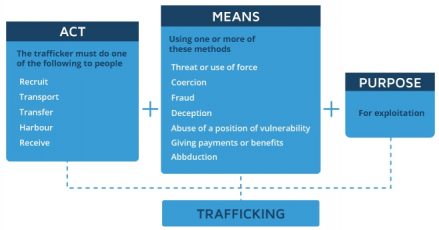Human trafficking is a serious problem that affects communities around the world. It refers to illegal acts of recruiting, transporting, and harboring people by using force and other means of intimidation. Despite meeting the minimum standards for the elimination of those crimes related to human trafficking, the United States still shows alarming numbers in terms of confirmed cases. In 2020 alone, there were 10,583 instances of human trafficking cases in the U.S. with the majority of victims being women (80%).
Understanding human trafficking
Human trafficking is an act of modern slavery that involves the unlawful and forceful recruitment, transportation, transfer, or harboring of people for further labor or sexual exploitation. Individuals of all genders and socioeconomic backgrounds can become victims of trafficking but those coming from poor or dysfunctional environments are particularly targeted.
From the perspective of criminal law, human trafficking consists of three core elements: the act, the means, and the purpose. Law enforcement authorities apply these elements to determine the essence, context, and outcome of the crime.
The ultimate outcome of trafficking is almost always some form of exploitation.
Some common types of human trafficking include:
- Sexual exploitation
- Forced labor or labor exploitation
- Debt bondage
- Domestic servitude
- Organ removal
- Forced marriage
- Forced begging
- Forced involvement of children in military operations
Fig. 1. The core crime elements of human trafficking

Source: UNODC – Human trafficking: the crime
Human trafficking in the USA
The Government of the United States claims to fully meet the minimum standards for the elimination of human trafficking by having implemented the following measures:
- increasing the number of investigations of trafficking-related crimes
- Increasing the number of victims served by federal grantees
- strengthening the enforcement of the prohibition of imports made wholly or in part by forced labor
- issuing the first national action plan to combat human trafficking.
Despite these efforts, the U.S. Department of State reports that advocates from indigenous communities and NGOs have highlighted a number of important limitations and setbacks that have undermined progress. For instance, some policies adopted and implemented by the federal authorities have further marginalized those communities targeted by traffickers thus increasing the risk of them falling victims to human trafficking.
There has also been limited progress in addressing labor trafficking and the obstacles within federal labor protection laws, according to U.S. authorities.
Statistics and facts
Human trafficking flourishes when is hidden away from public eyes, thus only a fraction of the actual problem is known to the authorities. In comparison with other countries, the U.S. has several organizations that are working towards gathering, processing, and reporting extensive data sets on the issue of human trafficking.
The National Human Trafficking Hotline, a U.S. based organization that connects victims and survivors of sex and labor trafficking with governmental services, is one of the most active in this field and has published some significant human trafficking statistics from the USA:
*The data is non-cumulative (i.e., the cases may involve multiple victims)
As these statistics show, in spite of the efforts to curb the incidence of human trafficking, the U.S. still registers high numbers of cases associated with this crime.
See also: Ten solutions to stop human trafficking
DevelopmentAid is the leading provider of business intelligence and recruitment tools designed to assist those active in the development sector. Join today and gain access to exclusive information on upcoming funding opportunities (tenders and grants) from the largest international donors.

